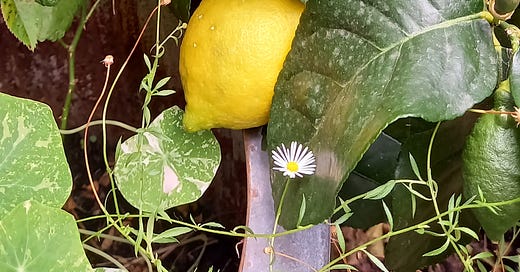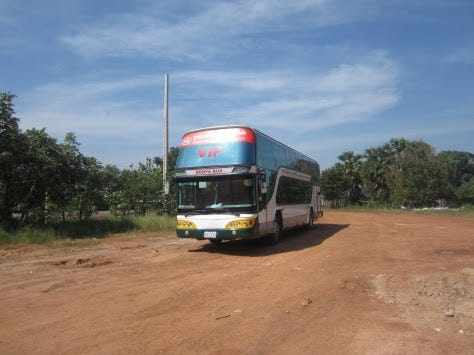The road from Siem Reap in Cambodia to the Poipet border post in Thailand is 93 miles long. On a good weather day, the journey when I travelled down it a little over a decade ago took around 6 hours by local bus. To have called it a road was to grant it a compliment it wasn't due. The surface was no more than compacted red dirt which after any rainstorm turns quickly into a rutted field.
Traffic slalomed from side to side to avoid the potholes. Still, our bashed-up bus was delayed by one of the punctures common on this route. Immediately, children appeared from nowhere bearing trays of snacks to sell through the windows. The land on either side was flat and given over to rice paddies. Women hunkered down among the bright green stalks of the forthcoming crop, trapping some animal in the waters to turn into a traveller's temptation grilled over tiny charcoal braziers. By the time our meat appeared on skewers in small cooked chunks, you wouldn't have been able to identify it.
It was rat. Rat does not taste just like chicken. It tastes like beef - or, according to tourists who profess to know what they are talking about - like dog. Those we saw in cages along the roads and in town markets, bred for their meat.
Spiders were another offering popular among my fellow passengers. They are caught in holes and eaten like tiger prawns by tearing off their legs and carapace and sucking out the juicy flesh. We washed down our snacks with swigs of bottled water from large plastic bottles. Cambodia's cheapest comes from the sepia-coloured Tonle Sap river, purified by reverse osmosis which leaves the water safe to drink but tasting vaguely of sewage.
This summer, it’s hot in the west, too, if you haven’t noticed. In a desperate effort to keep cool, we’re drinking more bottled water than ever. Perhaps we shouldn’t.
French NGO ‘Agir pour l'Environnement' (Acting for the Environment) put France’s best-selling mineral waters under the microscope. It scrutinised Evian, Perrier blue bottle, Vitell, Volvic, Cristaline, Badoit, and the supermarket chain Carrefour's water from the Montclar spring in the Alps. Results of their tests were released last week.
78 percent were contaminated with miniscule fragments of plastic less than 5 millimetres long.
They’re everywhere, these microplastics. Scientists have found them in meat and dairy products, in fish, in human blood - even close to the summit of Mount Everest. Most of the microplastics, the report concluded, came from the plastic bottle. Moreover, when subjected to strong heat and light it found, “These water bottles could release even greater quantities of microplastics.” Umm, would that be the plastic bottle nestled alongside you on your beach towel in the sun?
Plastic kettles and baby bottles also shed microplastics, researchers at Trinity College Dublin reported last October. If parents shake baby formula up in hot water inside a plastic bottle, they calculated the infant could end up swallowing more than one million microplastic particles each day.
We’ve tended to assume that a bottle of water sourced from a spring would be devoid of impurities. It is - until the water goes into the bottling process. In 2018, scientists at the State University of New York tested plastic bottled water and found twice as many plastic particles in it than in tap water.
Danone and Nestlé, producers of bottled waters, dismissed the French NGO’s findings. So, too, did trade association NMWE (Natural Mineral Waters Europe). Responding for the bottled water industry, it said not enough was yet known about the subject. Even the World Health Organization (WHO) agreed. It concluded there was insufficient information to draw a firm conclusion on the toxicity of microplastics, and no reliable information suggesting it was a concern.
Really? A 2019 World Wildlife Fund report concluded that through normal water and food consumption, the average person consumes an estimated 5 grams of plastic each week - the size of a credit card. Toxic chemicals also adhere to the surface of plastic such as the film we use to microwave food or supermarkets wrap our produce in. “The possibility of plastics in our fruit and vegetables is extremely alarming,” said ocean campaign director for Greenpeace USA, John Hocevar. “Decades of plastic use have contaminated our air, water, and soil. Eating just a bite of an apple could now mean eating hundreds of thousands of bits of plastic at the same time.” He called for additional studies, “To assess how much plastic we are consuming through our produce each day and examine how it is impacting our health.”
In response to the French NGO’s findings, NMWE did agree that microplastics are “everywhere”, even in the air we breathe, with over half caused by car tyres and building construction.
The NGO isn’t happy with that statement. It believes there’s not enough regulation over bottled water. “It is unacceptable to let bottled water manufacturers sell water polluted with microplastics but presented as supposedly ‘pure’.”
Not so long ago, Dasani bottled water, a CocaCola product worth $3.79 billion in sales, was discovered to be no more than common tap water to which they add table salt and Epsom salt - magnesium sulphate, which is why the brand was pulled from the UK market.
So, you might safely conclude that you can drink almost any old tap water, as long as it’s not stored in one of the billions of plastic bottles headed for landfills but in your own insulated metal bottle to keep it cold.
One of the better hot weather drinks - though it could hardly be described as a thirst quencher - is Limoncello.
7 well-scrubbed or organic lemons, strips of peel only (no bitter white pulp)
7 lemon leaves (optional - but an improvement. Middle East markets sell lemons with them attached)
1 litre/35 fl oz of vodka ( any cheap bottle will do)
750g/26 oz sugar
Infuse the first three ingredients in a glass or china bowl for at least 48 hours and up to 6 weeks for a really strong flavour.
Melt the sugar in 1 litre of boiling water and leave to cool.
Pour the alcohol, peel and leaves into the sugared water, then into a large storage jar and store in a freezer (the alcohol prevents it from freezing), a fridge, or a dark place. If you’ve waited 6 weeks, now strain the liquid from the zest and leaves into bottles. Me, I can’t wait. I leave it all 48 just hours then strain and drink.
You can also dribble this over ice cream, fruits, and lemon drizzle cake for a fabulous extra punch.







Terrifying details on plastic micro bits and pieces in bottled water. In Greece every café, kiosk, bar must be law sell a small bottle of water for 50 cents - essential given summer heat. I wonder if they have ben tested for what floating in the water. Greek tap water like most tap water all over Europe is just fine IMO.
We make our own limoncello with Meyer lemons from the tree we gave our daughter as a housewarming present. One improvement you might like: we chop up the lemon zest so there’s more surface area to infuse in the alcohol.
We also like to make limoncello martinis by substituting it for vermouth. Especially good as a “dirty” martini made with a splash of olive juice from the jar.